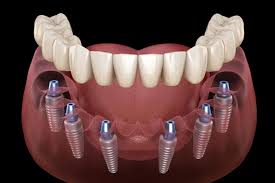Losing many or all of your teeth affects more than your smile – it impacts your ability to eat, speak, and maintain facial structure. That’s why some patients are choosing the All-on-4 permanent denture alternative as a durable, functional, and aesthetic solution. Rather than relying on traditional dentures that may slip or need constant adjustment, modern full-arch implant systems offer stability, comfort, and a renewed sense of confidence.
What Is Full-Arch Implant Treatment?
Full-arch implant treatment refers to replacing an entire upper or lower set of teeth using a fixed prosthesis supported by dental implants. It’s designed for people who have lost many teeth, have failing dentition, or want to avoid removable dentures altogether.
Key Features
- Just four to six implants are placed to support a full arch of prosthetic teeth.
- The posterior implants are often tilted to maximize use of available bone, which can often reduce or eliminate the need for bone grafting.
- Immediate loading is common: a temporary prosthesis can often be attached on the same day as the implant surgery, allowing you to leave with a functioning smile.
These features combine to offer significant improvements over conventional dentures in stability, appearance, and quality of life.
Benefits of Choosing the Full-Arch Implant Route
When done properly, full-arch implants bring many advantages for people seeking reliable tooth replacement.
What Patients Experience
- Stability and Function – Because the implants are fixed in the jawbone, the prosthetic arch does not move, slip, or require adhesives. Eating, speaking, and laughing feel more natural.
- Preserved Jawbone and Facial Structure – The implants stimulate bone, slowing or stopping bone loss that often accompanies missing teeth. This helps maintain the shape of the jaw and prevent the sunken appearance sometimes seen with long-term tooth loss.
- Aesthetics and Confidence – Prosthetic teeth can be designed to look very similar to natural teeth in terms of color, shape, and function. Many patients report improved self-esteem and comfort in social situations.
- Efficiency and Fewer Surgical Sessions – Because only a few implants are needed, and because grafting is often reduced, the process tends to require fewer surgical interventions, shorter treatment timelines, and less morbidity.
- Longevity – With proper care, these restorations are meant to last many years – decades in many cases – making them a worthwhile investment for many.
Is Full-Arch Implant Treatment Right for You?
Not everyone is an ideal candidate, but many more people are suitable now than in the past thanks to advances in technique and materials.
Candidate Considerations
- Sufficient jawbone density or willingness to undergo targeted grafting if needed.
- Good general health, without medical conditions that severely impair healing.
- A commitment to maintaining oral hygiene, because implants need care to last.
During an initial consultation, imaging (such as 3D scans), medical evaluation, dental examination, and planning are used to determine how the procedure can be tailored to your needs.
The Procedure: What to Expect
Knowing the steps ahead of time helps reduce anxiety and ensures realistic expectations for healing and recovery.
Typical Workflow
- Consultation & Planning: Evaluations, digital scans, determining implant positions, prosthetic design.
- Surgical Implant Placement: Four implants are placed – usually two vertical in front, two angled in back – to maximize bone contact without needing major grafts.
- Temporary Prosthesis: Often attached the same day, so you leave with functioning teeth while healing occurs.
- Osseointegration Phase: Over the next few months, the implants fuse with the bone. During this time, some diet restrictions and careful oral hygiene are essential.
- Final Prosthesis: Once healing is sufficient, the permanent arch (often made with durable materials like zirconia or high-grade acrylic) is attached.
Caring for Full-Arch Implants: Maintenance & Longevity
As detailed on the http://temeculafacialoralsurgery.com website, a full-arch implant solution is a long-term commitment, and proper aftercare strongly influences how well it holds up over time.
Key Aftercare Steps
- Brush and floss daily, treating the prosthesis like natural teeth.
- Regular dental checkups to monitor implant health, gum condition, and prosthetic integrity.
- Avoid habits that stress teeth, such as chewing hard objects or smoking.
- Use protective devices, such as nightguards, if you grind your teeth.
With these steps, many patients enjoy decades of reliable use, often 20 years or more.
Addressing the Concerns & Misconceptions
People often have questions or concerns when comparing full-arch implants with more traditional treatments.
Common Misconceptions
- “They’re too painful” – Many patients report discomfort immediately after surgery, but pain is generally manageable with modern anesthetics and medications.
- “Bone grafting always required” – Because implants in back are angled, many practitioners avoid grafts in many cases.
- “It’s prohibitively expensive” – While the upfront cost is higher than simple dentures, full-arch implant treatments reduce or eliminate many recurring costs (adhesives, repairs, replacements) over time.
Being well informed and working with experienced surgeons helps ensure the right choice for your situation.
Final Thoughts: A Smile That Works for You
Switching to a full-arch implant solution is more than restoring teeth – it’s restoring quality of life. It’s about being able to eat, speak, laugh, and live without the limitations that come with missing teeth or unstable dentures. When you explore treatments like All-on-4, you’re investing in function, beauty, and long-term oral health. If you’re considering this kind of reconstruction, reach out for a comprehensive evaluation. With careful planning, skilled care, and commitment, it’s possible to walk away with a natural, confident smile that lasts.

